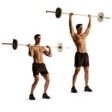 Analysis By Dr Paul Batman PhD
Analysis By Dr Paul Batman PhD
Client Instruction
Starting Position
- Grasp the bar with a pronated grip, positioning your hands slightly wider than shoulder width apart. Secure the bar so that it rests on your chest.
- Your feet should be shoulder width apart and directly under the bar with your knees slightly bent. Your elbows should be pointed downward and forward
- Tighten your abdominals to secure your low back
 Up Phase
Up Phase
- From this starting position, inhale and hold your breath as you press the bar upward. Continue to extend your arms until they are straight with your shoulders elevated. As you reach the final position in front of your upper chest, exhale during the final parts of the lift.
Down Phase
- When your arms are almost fully extended, pause and slowly lower the weight back to the chest high starting position.
- Keep your back straight at all times and avoid hyperextending your trunk
Muscle Analysis
Up Phase
Joint Action Contraction Muscle Group
Shoulder Joint Abduction Concentric Shoulder Joint Abductors
Elbow Joint Extension Concentric Elbow Joint Extensors
Down Phase
In the down phase of the exercise the weight is lowered slowly with gravity. The same muscles that concentrically contracted to lift the weight are the same that are eccentrically contracting to lower the weight.
General Kinesiological Analysis
In the shoulder press, the shoulder joint is abducted by the concentric contraction of the supraspinatus and anterior deltoid. The scapula is abducted by the serratus anterior and the pectoralis minor, followed by upward rotation from the contraction of the serratus anterior and the trapezius. The elbow joint is extended by the concentric contraction of the triceps and the anconeus.
Advanced Kinesiological Analysis
The supraspinatus and the anterior deltoid are the prime movers at the shoulder joint in a shoulder press. In a shoulder press, the humerus is laterally rotated prior to the press. This starting position places the anterior deltoid in the best position to pull on the humerus causing abduction. During abduction of the shoulder joint in the up phase of the shoulder press, the clavicular portion of the pectoralis major becomes active at approximately 110 degrees. At this point the muscle’s line of pull is above the centre of the shoulder joint, allowing the insertion to pull on the humerus.
As the anterior deltoid contracts to cause abduction, it also attempts to cause medial rotation and horizontal adduction of the shoulder joint due to its angle of pull. To prevent this from occurring, the infraspinatus and teres minor and the posterior deltoid contract statically to neutralize this unwanted movement.
If the shoulder press is performed with a narrow grip and the elbow pointed forward of the body, the muscle recruitment pattern will change. In this starting position, the up phase is caused by the shoulder joint flexing caused by the concentric contraction of the clavicular portion of the pectoralis major, coracobrachialis, anterior deltoid and the short head of the biceps brachii. As these muscles cause flexion, they also have a tendency to cause medial rotation of the humerus. This unwanted movement is prevented by the static contraction of the infraspinatus and teres minor. The narrow grip shoulder press will recruit the clavicular portion of the pectoralis major throughout its full range of motion. The coracobrachialis and the biceps brachii are recruited in this exercise. These muscles are not recruited when the exercise is performed in a wide grip shoulder press.
The triceps and anconeus are the prime movers that extend the elbow joint. The anconeus plays a more significant role when the weight that is lifted is heavy. It has been reported that the lateral and medial heads of the triceps are more active in the shoulder press, while the long head is used sparingly.
As the shoulder joint begins to abduct to lift the weight, the trapezius, pectoralis minor and the rhomboids contract statically to stabilize the scapula to allow the supraspinatus and deltoid to contract from a firm base. Once the weight is being lifted, the scapula begins the move into abduction. At this time the degree of stabilization of the abdominals and the spinal extensors is increased.
In the initial movement of the scapula, the serratus anterior and pectoralis minor contract to cause abduction. For this to occur there must be a simultaneous neutralizing of their additional movements of upward and downward rotation. As the shoulder continues to abduct, the scapula must move into upward rotation caused by the concentric contraction of the serratus anterior and the trapezius. When both these muscles contract in unison to cause upward rotation, they neutralize the additional adduction and abduction that each will also cause.
A variation of the barbell shoulder press is the dumbbell shoulder press. The difference between the two exercises is the weight apparatus. The shoulder and elbow joint actions are the same, as are the muscles responsible for the movement. When using dumbbells over barbells or machines for the same exercise there is a greater stabilization and neutralization required. In barbell exercises, the bar itself can act as a brace or neutralizer, while the dumbbell exercises require the surrounding muscles for each participating joint to be responsible for all roles.
